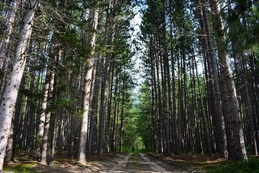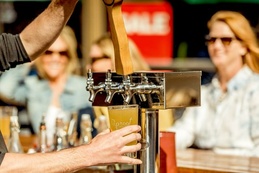
The Art of the Decoy
World-renowned faux fish are made right here in northern Michigan
By Art Bukowski | Nov. 1, 2025
On mantles and shelves around the country (and indeed, around the world) sit intricate and beautiful wooden fish decoys that began as blocks of wood in the cozy workshops of three northern Michigan artisans.
In a practice that was far more prevalent in years past, ice fishermen use these decoys to lure pike and other game fish close enough to be speared through a large hole in the ice. These carvings have become collectible over time, with examples from noteworthy early carvers fetching thousands of dollars at auction.
Most carvings made by Dave Kober and the married team of Fred and Jo Anne Campbell of BenzieJo Decoys never see the water. They’re made for people who want to buy them as folk art, and those clients are numerous. Kober and the Campbells have sold well over 13,000 pieces combined over the years, and they don’t show any signs of slowing down.
Dave Kober
Kober’s shop was on M-115 near Cadillac for many years, but he now lives and works near Thompsonville. He’s well known in the decoy world, having earned state and national recognition for his work.
Now 86, Kober is a Grand Rapids-area native who grew up on a fruit and dairy farm before a career in environmental remediation. His “fishaholic” grandfather carved decoys many moons ago, giving a very young Kober a first taste of what would become a lifelong hobby.
“I’ve still got some he carved before the turn of the century,” Kober says. “Those were decoys he used to feed his family.”
Kober was well into adulthood before he really leaned into carving, first for friends and family by request and then for the general public. Word began to spread about his work, which is easily recognizable for its distinctive style and dynamic poses.
“I’ve always tried to animate my stuff and give it a little character,” he says. “I had an outdoor writer one time that [said] it’s like I step on their tails to wake them up.”
He roughs out each piece with a saw, but then finishes the carvings completely by hand. Some wood (mostly cedar) he sources from suppliers, while other pieces end up in his possession from people who are aware of his craft.
“There’s all kinds of cedar in this area and people know that I use it, so when they’re cutting stuff down, they’ll call me and tell me I better come over,” he says. “Sometimes I come home from coffee and there’ll be a nice log leaning against the front door of my shop, and I’ll never even find out where it came from.”
Regardless of where it came from, Kober lets the wood do the talking when he sits down to work on a decoy.
“Each piece has got a distinctive characteristic to it, and it’s the grain of the wood that tells the whole story,” he says. “I follow the grain, and that dictates what the end product is going to be.”
After the carving comes painting. All told, he puts in 30-40 hours for each piece, which mostly sell for $150-$300 depending on size or other factors. He carves a core set of 40 freshwater species, and several dozen collectors have completed the full set. But most are one-offs, and he’s sold a lot over the years.
“Every piece has a control number, and it’s in my logbook,” he says. “I’m well over 8,000 the last time I checked, and I haven’t checked in a year or so.”
Most people these days call or email him to order directly. His current home and shop is off the beaten path, and that’s a good thing. His old highway location started bringing in too much business.
“I had my shop on M-115 there south of Cadillac and it was just too busy. It got to the point where I couldn’t work,” he says. “There were just too many people coming in.”
He also used to supply pieces to dealers and shops across the country, but dropped that line of business as well.
“It got to the point where it went from a hobby to job, having to meet deadlines and stuff,” he says. “So now it’s all just word of mouth.”
These days he’s selective about the orders he accepts. Most current work is standard decoy size, as he’s entirely quit his practice of making super-sized carvings (he has a 10-foot muskie hanging in Boone’s Long Lake Inn and another in the Mall of America, two of several giant pieces across the country).
“I never do get quite caught up entirely where I don’t have outstanding orders,” he says. “But I pick the ones that I want to do because I know I can do a nice job on them, and that I don’t have to kill myself physically to complete.”
The “nice job” part is important to Kober, who, like many top artisans, is his own biggest critic.
“Every now and then I have a piece where I’m half done with it, but I throw it in the wood stove,” he says. “If it doesn’t satisfy me, I don’t even want anyone else to see it.”
Even after all these years, he still derives great joy from happy customers.
“What’s better than getting an ‘attaboy’ when people stand there with something you made by hand with a big smile on their face?” he says. “There’s nothing better than that. That’s what you’re after.”
Kober has sent fish all across the country and to several locations overseas. He’s honored to know that his pieces are sought after and hold a special place on display in thousands of homes.
“People are going to remember me when I’m gone, that’s for sure,” he says.
BenzieJo Decoys (Fred and Jo Anne Campbell)
The Cambells, married for almost 40 years, work out of their home south of Benzonia, just a stone’s throw from the Manistee County line. All of their vivid decoys are a team effort—Fred carves and Jo Anne paints.
In their working lives, Jo Anne was an insurance agent and Fred was a plant manager. They also owned and operated motels and a gift shop in Wellston, where they lived for many years before moving to Benzonia.
Fred had already gotten into chainsaw carving when he happened to stop by a flea market where a man was selling fish decoys. He thought it looked interesting and gave it a try, launching a nearly 30-year run of decoy production. He connected with other carvers to learn the tricks of the trade, and eventually roped Jo Anne into the hobby.
“I told her, ‘You know, I’m really tired of painting,’” Fred recalls. “And she says ‘Well, if you carve them, I’ll paint them.’”
The two have become a well-oiled machine, having produced somewhere around 4,000 decoys over the last three decades.
“Let me put it this way—we’re each other’s biggest fans, but we’re also each other’s biggest critics,” Jo Anne says. “So if he gives me a decoy that I think needs more work, he knows it. But I’m probably a bit more outspoken than him because he always compliments me and tells me what a good job I did, even if I’m disgusted with it.”
“I have probably 40 fish in there lined up for Jo Anne to paint right now,” Fred says. “I can carve them and test them a lot quicker than she can paint them.”
That’s at least in part because Jo Anne is meticulous about researching what these fish look like in real life and then carefully recreating their patterns. Their trout in particular have won several awards for their artistry largely because of this attention to detail.
“I do a lot of research on the internet, but I also get a lot of pictures sent to me by fishermen. You get the best picture when it’s fresh out of the water,” Jo Anne says. “I think sometimes I maybe exaggerate the colors a little bit, but if you were to see them underwater, they are very bright.”
Fred and Jo Anne are also inspired by the fish themselves, especially the trout. Their Facebook page serves to educate readers about the natural histories of these fish just as much as it serves to sell decoys.
“I get quite attached to their stories. Where are they native? How were they named?” Jo Anne says. “It gives them all a bit of personality. And they’re like people. They’re all different.”
Like Kober, the Campbells are tickled to know their pieces are in collections all over the globe. They sell on eBay, Etsy, and through direct order. Pieces start at $90, with price depending on size and other factors.
“We’re really proud of that,” Jo Anne says. “We’ve got them over in Finland, in Germany, in the UK, in Singapore…and I think we’ve probably got one in every state.”
They also do good business at the weekly Frankfort farmer’s market. “We get a lot of repeat business at that market,” Fred says. “People coming back year after year, and they pick up another one for their collection.”
Fred and Jo Anne also make and sell so-called “working” decoys, which are used by ice fisherman for their originally intended purpose. This requires extra work, as these working decoys need to be carefully balanced with lead weights to ensure they swim properly.
Their shop has photos from fishermen of several massive pike lured to the spear by these decoys. “We take a lot of pride in that,” Jo Anne says.
Trending

Wreath the Halls
Get ready for the holidays with the ultimate wreath workshop! Boyne Mountain hosts Wreathfest, Saturday, Nov. 8, with Kalin … Read More >>
Saving Wild Elk Country
This fall, the elk population got a helping hand from their human friends. Gaylord-based conservation nonprofit Huron Pines … Read More >>
Drinking Habits
The AuSable Artisan Village Community Theatre is leaning into a play on words with their upcoming production of Drinking Hab… Read More >>


